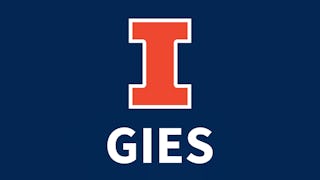Through this course you will not only learn key financial concepts, but how to apply them to a business to improve its financial prospects.


您将获得的技能
- Accounting
- Capital Budgeting
- Corporate Finance
- Corporate Communications
- Business Risk Management
- Financial Statement Analysis
- Cash Flows
- Return On Investment
- Business Valuation
- Performance Measurement
- Stakeholder Management
- Risk Management
- Key Performance Indicators (KPIs)
- Financial Statements
- Financial Modeling
- Environmental Social And Corporate Governance (ESG)
- Corporate Sustainability
- Financial Analysis
要了解的详细信息

添加到您的领英档案
August 2025
33 项作业
了解顶级公司的员工如何掌握热门技能

积累特定领域的专业知识
- 向行业专家学习新概念
- 获得对主题或工具的基础理解
- 通过实践项目培养工作相关技能
- 获得可共享的职业证书

该课程共有5个模块
Sustainable businesses need to earn consistent and predictable profits. But accounting profits alone are not enough. Let’s say you’re in the happy position of owning a profitable business outright, and your business managers are generating and reporting $1 million of annual profits and cash flows for you, the 100% owner. So far so good? Well, depending how much of your capital is tied up in the business, $1m annual profits might not seem so good after all. What if the net business assets – for example a building – were worth $1 billion – 1,000 times as much as the annual profits? This business is using, and tying up, $1bn current market value of your capital, that you can’t deploy elsewhere. Your managers are only achieving a rate of return on your capital of $1m / $1bn = 0.1% per annum. You could probably achieve a greater rate of return – for a similar level of risk – by deploying the capital elsewhere. So – as the business owner – you’ll want to monitor your investment and your managers by the rates of return they’re achieving on your capital, as well as the $ amounts of profits. As business managers and project managers, we need, in turn, to understand our capital providers, and the rates of return our capital providers are – quite reasonably – requiring from their capital investments in the business we’re employed in.
涵盖的内容
8个视频4篇阅读材料5个作业
The amounts of reported profits and cash flows are fundamentally important. But so is their timing. $1m receivable tomorrow is better than $1m receivable in 10 years’ time. If we get $1m tomorrow, we might be able to use the money in a number of different useful ways. For example, we might be able to repay some borrowings earlier, and save interest expense. Or we might be able to deploy the $1m into another attractive investment opportunity. On the other hand, if we have to wait another 10 years to get our $1m, we won’t be able to use it in the meantime to repay any borrowings (nor to invest it elsewhere). So we’d clearly prefer to collect our money earlier, assuming we get our full amount of $1m in both cases. This preference reflects the time value of money. But what if we had to choose between getting a smaller amount of $0.8m tomorrow, or the full $1m in 10 years’ time? Tools for making that evaluation include Future value, Present value, and Net present value. These project evaluation tools are all Discounted Cash Flow (DCF) techniques, giving results in money terms. They factor in the timing of forecast cash flows as well as their amounts. And they also take account of the rates of return required by our capital providers.
涵盖的内容
9个视频1篇阅读材料7个作业
Another group of Discounted Cash Flow (DCF) project evaluation techniques includes Internal rate of return (IRR). IRR summarises a set of cash flows as a single percentage figure. The IRR measure is independent of any investor’s required rate of return. The greater the positive percentage IRR figure, and all other things being equal, the more attractive the proposal for an investor. IRR can also be used to evaluate the cost of different financing proposals. The lower the IRR, the more cost effective the financing appears to be on this measure. Yield is one of the many words in finance with a number of different meanings. In the context of borrowing and financing, yield is the internal rate of return (IRR) of the borrowing – or other financing – cash flows. Yield is also a measure of the rate of return on an investment in tradeable debt, for example a corporate bond. Total shareholder return (TSR) is a measure of the rate of return enjoyed by investors in equity shares (equity shareholders). TSR takes account of the capital value of the shares over time, together with any dividends on the shares over the same period, and any other relevant cash flows for the shareholder. TSR is calculated as the IRR of these relevant cash flows. Many companies whose shares are listed on an exchange use TSR as a key measure of the performance of their senior managers.
涵盖的内容
9个视频1篇阅读材料7个作业
Values and valuations are fundamentally important, but not always straightforward to quantify. Appropriate valuation techniques, and the values themselves, can depend on the circumstances, as well as the nature of the asset. One valuation method for a business is a DCF analysis of the entire enterprise. When a company’s shares are listed on an exchange, the latest traded price per share is quoted continuously during trading hours. The total current market value of the (equity) shares is simply the share price multiplied by the number of shares. This total figure is sometimes known as the market capitalisation, to emphasise the perspective that the current market price of the shares might represent an overvaluation – or an undervaluation – by the market. Multiples valuation means comparing values, or estimating values, based on a multiple of a relevant financial measure. Examples include PE ratios for a company’s equity, and EBITDA multiples for the whole enterprise (the total of the company’s equity and its debt). Market values imply a sale and purchase transaction, or a potential sale and purchase transaction, in the market. Book values, in this context, mean amounts reported in a company’s financial statements. Book values and market values can differ substantially, with market values of successful companies often greatly exceeding their book values. Reasons for the differences include valuable intangible corporate assets, that are not recorded in traditional financial statements. Book values for large organisations are audited, adding to the credibility of the reported book values.
涵盖的内容
7个视频1篇阅读材料6个作业
Growth enhances corporate value, while risk destroys value. Accordingly, managers can grow corporate value by appropriate sustainable growth of the future net positive cash flows of the business. In turn, this might flow from revenue growth, cost control – or both – assuming no change in related risk. Similarly, all other things being equal, applying risk management techniques to reduce the risk of future cash flows will increase their value, via a reduction in the required rate of return for the (now) lower-risk cash flows. In practice however, there will more often be a trade-off between improving – or worsening – forecast cash flows and related levels of risk. For example, discontinuing insurance cover will save insurance expenses, but increases the risk of suffering uninsured losses. The sustainability of the entire business, including its environmental sustainability, is increasingly a key dimension of its stakeholder risk management. Stakeholders include shareholders. A more subtle way to enhance shareholder value is to reduce the amount of capital that the company needs in order to operate. For example, by better working capital management. An example would be improving trade credit terms negotiated with and applied to customers and suppliers. In a simple case, this might enable the company to return capital to its shareholders for them to deploy elsewhere, while continuing to generate profits in the company. The stakeholders in a business include its shareholders, but also an increasing wide group of other people, organisations and potentially other entities. For example, one life sciences business mentions its stakeholders as including customers, employees, suppliers, industry organisations, local and central governments, those who live and work where the business operates, and society as a whole. Companies are increasingly – and explicitly – taking account of the interests and capital value of all of these other stakeholders, and professional management of the company’s relationships with them, and not just the company’s own shareholders as in the past.
涵盖的内容
10个视频1篇阅读材料8个作业
获得职业证书
将此证书添加到您的 LinkedIn 个人资料、简历或履历中。在社交媒体和绩效考核中分享。
位教师

从 Finance 浏览更多内容
 状态:免费试用
状态:免费试用Macquarie University
 状态:免费试用
状态:免费试用University of Illinois Urbana-Champaign
 状态:免费试用
状态:免费试用University of Pennsylvania
 状态:免费试用
状态:免费试用Fundação Instituto de Administração
人们为什么选择 Coursera 来帮助自己实现职业发展




常见问题
To access the course materials, assignments and to earn a Certificate, you will need to purchase the Certificate experience when you enroll in a course. You can try a Free Trial instead, or apply for Financial Aid. The course may offer 'Full Course, No Certificate' instead. This option lets you see all course materials, submit required assessments, and get a final grade. This also means that you will not be able to purchase a Certificate experience.
When you enroll in the course, you get access to all of the courses in the Specialization, and you earn a certificate when you complete the work. Your electronic Certificate will be added to your Accomplishments page - from there, you can print your Certificate or add it to your LinkedIn profile.
Yes. In select learning programs, you can apply for financial aid or a scholarship if you can’t afford the enrollment fee. If fin aid or scholarship is available for your learning program selection, you’ll find a link to apply on the description page.
更多问题
提供助学金,



